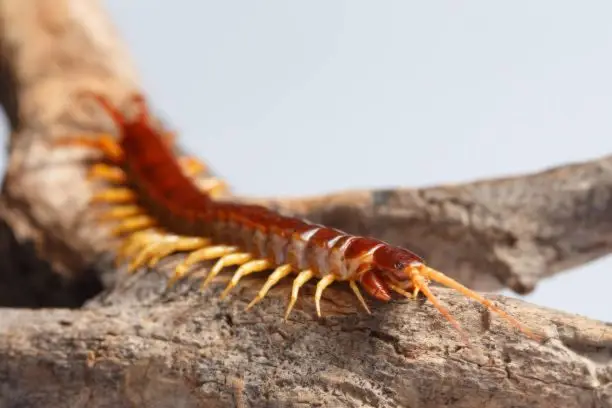Centipedes can seem like the evil twin of the humble millipedes especially when you consider what centipedes eat.
Depending on the size and species of the centipede, there are a number of dietary needs and best practices to consider.
In this article, we’ll offer a complete centipede food guide, so you know how to give your pet the best nutrition possible.
Table Of Contents:
ToggleWhat Do Centipedes Eat?
In the wild, centipedes typically eat small insects and other arthropods, like worms and snails.
Species of centipedes may also vary depending on what they eat – some specialize in eating eggs, while others specialize in hunting mites and flies.
They typically use their poison pincers to ambush their prey and inject them with venom.
Centipedes may also supplement their diet by scavenging dead insects or performing ‘raiding runs’ by coming out during the night and raiding spider webs for the trapped insects.
Much like spiders, centipedes rely on their senses of touch, smell, and taste to locate their food.
When hunting, they make use of their antennae to sense the presence of prey even when they’re at long distances.
Buy Centipede Food
When buying food for your pet centipede, it’s important to know what kind of food to purchase.
Many centipedes enjoy a diet of mealworms, snails, and small crickets, while larger species often need larger prey such as roaches or even mice.
Some pet stores and online retailers sell pre-packaged centipede food.
It’s important to check the label to make sure it has the right sizes, quantities, and types of food for your pet.
How To Feed a Centipede
This how-to-feed centipede food guide is designed to help pet owners make an informed decision on how to best feed their centipede.
With the information provided in this guide, you will be able to give your centipede appropriate nutrition with confidence.


Materials:
Steps to feeding a centipede
When To Feed A Centipede
When it comes to centipede feeding, I recommend you follow a regular schedule.
Generally speaking, it is a good idea to feed the centipede once per week.
However, this can vary based on the species of centipede and the size of the prey you are feeding.
It is important to observe the centipede for a few days to determine how often it looks for food, as this will give you an indication of its natural feeding habits.
If you feed the centipede too often, it can become obese and unhealthy.
On the other hand, if you don’t feed it often enough, it can become too stressed, sick, or worse.
Common Mistakes
One of the more common mistakes made when feeding centipedes is giving them protein-rich foods.
Centipedes are actually predators and prefer to eat small insects and other arthropods.
Vitamin-enriched insect chow is not a suitable meal for them.
Plant materials like greens, mushrooms, berries, and vegetables can help supplement their diet, but they should not be the primary source of food.
Another common mistake is feeding too often. Centipedes can go weeks without food, and should not be overfed.
Some centipedes can eat up to 5 or 6 meals in a week, while others only need to be fed every other week.
It’s important to pay attention to your pet and its eating habits so you’re not overfeeding them.
Lastly, centipedes should not be fed directly from your hand.
Not only can this be a bit uncomfortable for your pet, but you could also get bitten.
Instead, it’s best to put the food in the centipede’s habitat and leave it to eat in peace.
Conclusion
Properly feeding your centipede is essential to ensuring a healthy and long life.
But with the right information and resources, it doesn’t have to be complicated.
Whether you’re buying commercial centipede food or sourcing other food items, remember to check the size and ingredients before you feed them.
With the help of this DIY centipede food guide, you should be able to both provide the nutrition your pet needs and have a great time doing it.
Frequently Asked Questions
Yes, centipedes are carnivorous and primarily feed on insects, spiders, and other small invertebrates.
The frequency of feeding a centipede depends on its size, species, and activity level. Generally, they can be fed once or twice a week, or every other week for larger species.
No, centipedes are carnivorous and cannot digest plant matter. They require a diet of live prey such as insects, spiders, and other small invertebrates.
No, centipedes do not prey on humans. While they have venomous bites that can be painful and cause swelling, they generally do not view humans as prey and will only bite in self-defense.
It can be difficult to tell if a centipede is hungry since they are opportunistic predators that will eat whenever prey is available.
However, if a centipede has not eaten for an extended period of time, it may become more active in its search for food.

